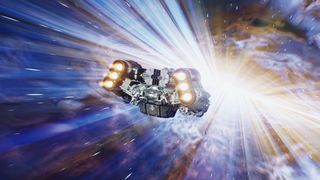There are over 100 Starfield star systems to find and explore which are grouped by level. That creates a range of difficulty tiers depending on where you try to go at your current level. Theoretically, you can plow straight into the toughest systems from the word go as a baby faced new explorer, just don't expect to last long.
Across the 100+ star system there are 1000 odd planets to explore and while they won't all be bustling galactic hubs, there's a lot to potentially discover. To make it all a little easier, here's all the details we know about planets and Starfield star systems that have currently been revealed, mentioned or teased.
How many star systems are there in Starfield?

There's over 100 star systems in Starfield, and over 1,000 individual worlds within them. Of the different Starfield factions you can meet, join or fight, three of them will have bases in specific Starfield cities, with territories extending around where they call home. That likely means that certain systems will belong to certain factions, while others may be unclaimed, or even fought over. Not everywhere is going to be inhabited though - this is space, after all, and players start as professional explorers so expect plenty of unknown places to find.
All Starfield star systems so far
The following Starfield star systems have been revealed in some sort of detail so far:
- Sol - Sol is our own solar system home to both Earth and Mars. However, our world is no longer habitable in the Starfield universe, and players will get to find out why Earth was abandoned and a Mars settlement called Cydonia was set up.
- Alpha Centauri - This is the nearest system to Sol and the central HQ of the United Colonies faction capital. It's also home to one of the big main cities, New Atlantis which seems to be on a planet called Jerrison. For fact fans it has a total of four planets and eight moons.
- Narion - The official gameplay reveal features base building on this system's barren world of Vectera. It's very close to Sol and Alpha Centauri.
- Volii - This is a system close to Alpha Centauri, as revealed on a section of the Galaxy Map. This may be the headquarters of the Ryujin Industries faction and their pleasure city Neon, owing to a "Volii Hotel" sign seen in concept art for Neon.
- Cheyenne - This is another system close to Alpha Centauri and appeared on a revealed section of the Galaxy Map. It also currently looks like Crimson Fleet territory.
- Jaffa - This is yet another system again close to Alpha Centauri, and also shown on a section of the Galaxy Map.
- Porrima - This is a third system close close to Alpha Centauri and shown on a revealed section of the Galaxy Map.
- Kryx - This was revealed in a letter seen on screen during a video saying "Pirates of the Crimson Fleet have extended far beyond the Kryx system". It suggests that Krix might well be the base system for the pirates. The letter also mention that the Crimson Fleet have gone on to "establish footholds in the Sagan, Cheyenne, Lunara and Narion systems" suggesting they're all in proximity to each other.
- Sagan - Another system mentioned to be under Crimson Fleet control.
- Lunara - Another system mentioned to be under Crimson Fleet control.

Obviously the fact that there are 100 star systems in the game instead of the 100,000,000,000 stars in the actual Milky Way means players should expect a version of the galaxy that's been scaled down. We do know that Bethesda is being selective in their recreation - Alpha Centauri and Porrima are real star systems for example, while Narion and Volii appear to be fictional, or possibly existing systems under different names.
How to travel between star systems in Starfield

One of the Starfield ship customization stats is "Jump Range (Light Years)" which likely shows how far a ship can jump through the galaxy. So your range will have to match or exceed the distance to a system you want to reach - if it does you can then 'jump' to that system.
How Star system levels work in Starfield

Star systems in Starfield have levels that serve as means to control difficulty and gatekeep you as you play. The game groups star systems by level so players know where to go. In a podcast interview with Lex Fridman, game director Todd Howard explained the system accordingly:
Howard: "It'll be like when you look at a map on a game, it'll be like 'this is the area for low-level players, this is level one.' So we do this on a star system basis."
It's not made entirely clear whether these will be hard gates - aka, that require players to reach a certain level to get inside - or whether they'll simply be recommendations. However, considering Bethesda's previous design choices with open world games, it's very likely the latter, particularly considering that they don't even want your spaceship to run out of fuel.

